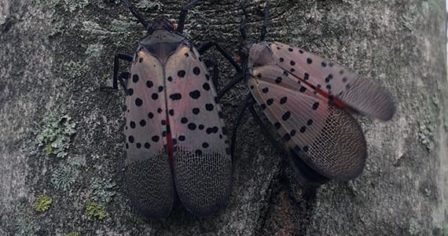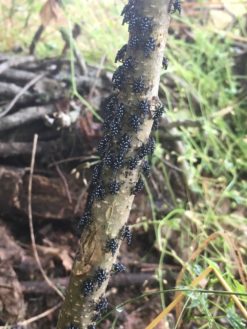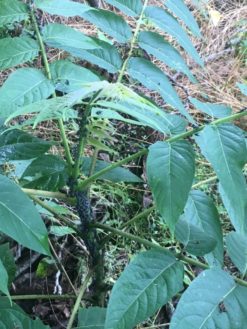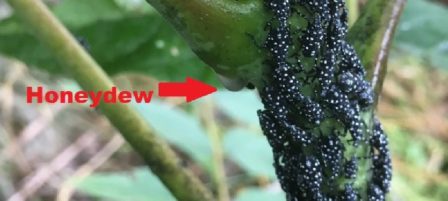Our office has been getting lots of questions lately about the Spotted Lanternfly. Many clients want to know “Will the Spotted Lanternfly kill my tree?”
The short answer is “not immediately.” The real answer involves knowing a bit more about their life cycle and how they behave. Read up on some Frequently Asked Questions about the Spotted Lanternfly.
 What is the Spotted Lanternfly?
What is the Spotted Lanternfly?
The Spotted Lanternfly is a bug that feeds on specific trees. It’s a type of bug known as a “plant hopper” – in other words, it can fly, and moves from plant-to-plant. It feeds on plants by using its “piercing-sucking mouth-parts” (similar to a mosquito) to pull fluid underneath the bark of trees. The pest’s mobility makes control for Spotted Lanternfly a huge challenge for Tree Care and Arborist services.
Where did Spotted Lanternfly come from?
Spotted Lanternfly is a native of Southeast Asia. It is a native of China, Taiwan and Vietnam. Many experts believe it traveled here in a shipment coming from one of these countries through international commerce. It was first detected in Berks County in 2014.
Can you stop it?
Again, the answer is “no.” The best we can do is to slow the spread of this pest, and protect your landscape.
There are few natural predators for this pest here in North America. However, a study from Cornell University found that two fungi (B. major and B. bassiana) in North America seem to provide control for adults. I emailed back and forth with one of the study authors, and it is unclear at this time if the native fungi will also help control nymphs. Researchers are actively trying to determine if the bacteria only control adult populations, or if these fungi can be used to control nymphs as well. B. bassiana is commercially available in products for nursery managers, while B. major is “poorly known” at this time.
What should I be looking for?
At this point in the year, you will see the “1st instar,” or first-stage of development. They’re called “nymphs” at this point in their life cycle. They’ll continue to look like this (black with white polka-dots) until they reach the 4th instar. The 4th instar is the last stage of their development before they become full-grown adults.
 Right now, you might see them anywhere. Adults lay their eggs on just about anything. We’ve had clients reporting nymphs on decks, potted plants, and patios. You will see these nymphs feeding near where the leaves emerge from branches, or on very young trees. This is because they’re piercing-sucking mouth-parts aren’t well developed yet, and the bark is thinner on young plants and at the end of branches.
Right now, you might see them anywhere. Adults lay their eggs on just about anything. We’ve had clients reporting nymphs on decks, potted plants, and patios. You will see these nymphs feeding near where the leaves emerge from branches, or on very young trees. This is because they’re piercing-sucking mouth-parts aren’t well developed yet, and the bark is thinner on young plants and at the end of branches.
How Do I Get Rid of Spotted Lanternfly?
There are several things you can do to try and manage this pest on your your property. Some involve treatments, while others are cultural practices.
Sticky Bands
Right now, you can use what are called “sticky bands” to help control the nymph population. Basically, this involves applying something similar to a giant “glue trap” to your tree. The idea is that the nymphs crawl onto the trap, get stuck, and never further their development. You can buy these products online.
These products are falling out of favor, however. They’re so sticky they’re catching “non-target” organisms, like birds and squirrels in some cases. A decent work-around for this is to simply use some cheap duct tape and DIY your own.
 Tree Identification
Tree Identification
Knowing which trees you have on your property is critical as well. The Spotted Lanternfly is able to complete it’s life cycle on a wide host of plants. It seems to prefer Ailanthus altissima or “Tree of Heaven” for feeding and reproduction. Identifying this tree, and removing it from your property, is an important part of management. Simply cutting it down will seldom remove the problem. You should consider consulting with a professional who can help you remove this invasive plant for good.
Spotted Lanternfly feeds on other plants, too. It will feed on anything with a high sugar content in the sap. In our area, this means any time of fruit or ornamental fruit plants. This includes grape vines (cultivated or wild), maple trees, pear, apple, cherry and plum trees (fruit-bearing or ornamental), and birch trees. Knowing if you have these plants on or near your property so you can look for the Lanternfly is an important part of management. Google images of leaves and bark if you’re not sure what these trees look like so you can educate yourself!
Treatments
Now that you know about cultural management practices (removing Ailanthus trees and sticky bands), you should consider treatment options. At this time, I recommend treating only the plants in your landscape that are A) most at risk, and B) part of your outdoor living.
We thought long and hard about our treatment options. We even consulted with some university researchers about the program before offering it to the public. Our program is designed to give you the best, season-long control possible in the most environmentally responsible way possible.
Before contracting with a professional to treat your trees, ask lots of questions. Do they understand the pest’s life cycle? How many treatments are they doing? Why are they doing those treatments? Have they consulted all the available information before formulating their plan?
Will Spotted Lanternfly Kill My Tree?
Back to the original question – “Will it kill my tree?” The answer is “probably not directly.”
Damage caused by piercing-sucking mouth-parts opens the bark. There’s an open wound on the tree. This leaves the tree susceptible to other bugs and diseases.
Think of it like this – a chest cold doesn’t necessarily kill you. If you leave it untreated, however, it can develop into pneumonia, and the congestion building up in your lungs is what kills you. Leaving your landscape trees untreated is like that – a chest cold. It’s not going to kill them immediately, but over time, it’ll only get worse and lead to plant death.
 What a mess!
What a mess!
The larger concern is that it will be a mess. As it feeds, Spotted Lanternfly secretes (translation: basically poops) a sticky substance called “honeydew.” The Lanternfly feeds in such high numbers, researchers often have to wear raincoats to keep dry. It’s even been described as being “rained on.” This picture at left is of nymphs, but the adults will be much worse.
This honeydew is also the perfect breeding ground for a fungus called “black sooty mold.” You can see some of it in this picture already forming. This is basically going to make outdoor spaces underneath these trees unusable. This will be especially true in public areas without treatment, like parks.
If you have questions about Spotted Lanternfly management at your home, business, municipality or school district, we’d love to speak with you. You may contact us here.
The post Will it Kill My Tree? – Spotted Lanternfly FAQ’s appeared first on Tomlinson Bomberger.
from Tomlinson Bomberger http://bit.ly/2Kr0rD0

No comments:
Post a Comment